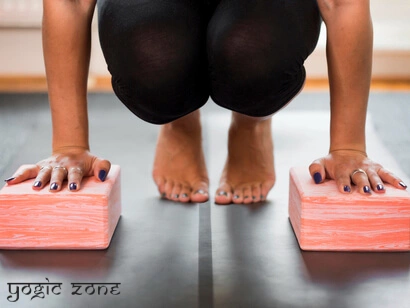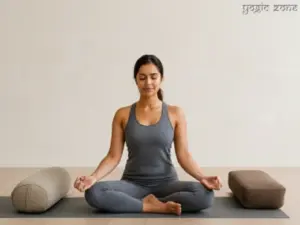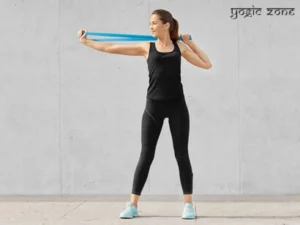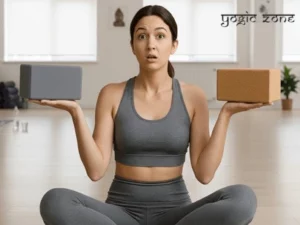
Yoga specialist and an independent yoga teacher | Advanced Teacher Training Course – 900 Hours TTC | Ashtanga Vinyasa Yoga 200 Hours. Know more about Sanhita Joshi.
As a yoga instructor, I often see how small changes in practice can bring big benefits. In this article, I will explain the yoga block uses and how I use them in my classes and personal practice. These lightweight props are ideal for seniors, beginners, or anyone wanting a safer and more balanced yoga experience. Blocks provide support, comfort, and confidence—especially if you are new to yoga or looking for safe alignment.
Yoga Block Uses—At a Glance
| Yoga Block Uses | How It Helps | Why It Matters |
|---|---|---|
| Support while sitting | Raises hips and reduces pressure on knees and back | Makes sitting easier for meditation or breathing |
| Gentle stretching | Extends reach without forcing the body | Helps improve flexibility safely |
| Balance and stability | Offers a steady surface when movement feels wobbly | Builds confidence and reduces risk of falling |
| Relaxation and rest | Supports back, head, or hips during gentle practice | Encourages deep rest and tension release |
| Breath awareness | Improves posture for deeper, more even breathing | Enhances focus and calm during pranayama or sitting |

Everyday Yoga Block Uses
Yoga blocks are not just for use in classes or by advanced yogis; they can be used at home and in many simple ways:
- Support While Sitting: If sitting on the floor feels difficult, I suggest placing a block under your hips. It helps ease pressure on your knees and back so you can breathe more easily and sit longer in meditation or pranayama.
- Gentle Stretching: When you find it hard to reach the floor or toes, place a block under your hands or feet. It lets you lengthen safely without strain. My students generally ask me:
“How do yoga blocks help with flexibility?”
Yoga blocks help by extending your reach, letting you hold poses comfortably while your muscles gradually open up. - Balance and Stability: I often guide my students to use a block while practicing standing poses. It boosts balance and builds confidence when movements feel shaky. Below are the answers to the questions that I am generally asked:
“How do I stay steady in balancing yoga poses?”
Place a block under your hand or beside your foot for extra stability. It gives a firm base and prevents wobbling.
“Why do yoga instructors suggest using blocks under your hand?”
Blocks reduce overreaching and support proper alignment, which keeps your joints safe and movements smooth. - Relaxation and Rest: In restorative yoga or when winding down, blocks can support your back, head, or hips, helping you relax deeply. Read our blog if you would like to know more about restorative yoga for beginners.
Another common question: “How do I support my back in restorative poses?”
Place one or two blocks under your upper back and head to open the chest gently and relieve tension. - Breath Awareness: Using blocks improves posture and helps you breathe more naturally. A small lift under your hips or spine encourages smooth, even breathing—ideal for meditation or pranayama.
Another common question: “Do yoga blocks help with standing poses?”
Yes, they do. Placing blocks under your hands in asanas like Trikonasana or Ardha Chandrasana improves balance and keeps your spine aligned.
Do you have any doubts or questions about this article?? I am Sanhita Joshi, the author, and I would love to hear from you. Send us your question now!
Foam vs Cork Yoga Block: Which Is Right for You?
Choosing the right block depends on your comfort and practice style:
| Type of Yoga Block | Feel | Best For |
|---|---|---|
| Foam Block | Soft and light | Gentle support, restorative use |
| Cork Block | Firm and stable | Strong grip, steady support |
Foam blocks are softer and helpful for relaxed or restorative practice, while cork blocks offer firmer support for balance poses. For a full comparison read our article on Foam vs Cork Yoga blocks.
Tips For Using Yoga Blocks
- Try Different Heights: Blocks can be used flat, sideways, or upright. Each height offers a different level of support; it’s a good idea to experiment to know which height feels best.
- Use on a Non-Slip Surface: Always place your block on a yoga mat or stable floor to prevent slipping.
- Start Slow: Even if you feel flexible, using a block can improve alignment and reduce strain. It’s not a shortcut—it’s a smart choice.
By understanding the yoga block uses, you can enjoy a safer, more comfortable practice. Yoga blocks are more than props—they’re tools for self-care. They help you move with ease and build confidence in your practice. Whether you are young or old, flexible or stiff, practicing alone or with a teacher, yoga blocks offer support that makes yoga feel more welcoming.
Do you have any doubts or questions about this article?? I am Sanhita Joshi, the author, and I would love to hear from you. Send us your question now!
Yoga Block Uses—FAQs & Gentle Guidance
How do I use a yoga block if I can’t touch the floor in yoga poses?
Place the block under your hands to “raise” the floor in poses like Forward Fold or Triangle. This helps keep your back aligned and prevents you from rounding or straining.
Are yoga blocks only for beginners, or can advanced yogis use them too?
Yoga blocks are for every level. Beginners use them for support, while experienced practitioners use them to deepen stretches and refine alignment.
Which yoga poses benefit the most from using a yoga block?
Common poses include Trikonasana (Triangle pose), Ardha Chandrasana (Half Moon pose), Setu Bandhasana (Bridge pose), and Paschimottanasana (Seated Forward Fold).
Can yoga blocks help with tight hips and hamstrings?
Yes. A block allows you to maintain posture without forcing flexibility. It helps you stretch safely and gradually increase your range of motion over time.
How do I use a yoga block to improve balance in standing poses?
In balance poses like Half Moon, place your hand on the block for support. The block stabilizes your foundation, helping you stay steady and aligned.
Can yoga blocks be used for restorative or relaxation-focused yoga?
Absolutely. Blocks can support your back, hips, or head to release tension and encourage deeper breathing in restorative practices.
How many yoga blocks do I need—one or two?
Two blocks are ideal because many poses use props on both sides of the body. However, you can start with one and add a second later if needed.



